 For watering indoor plants
For watering indoor plants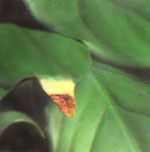 With excessive watering, the ends of the leaves becomebrown with pronounced yellowing. The need of plants for water is determined by their specific features: the structure of the above-ground organs, the power of the root system, etc. For example, plants with juicy, fleshy leaves (such as agave, aloe, etc.) need less water than plants with large leaves, which sometimes need to be watered twice a day. Excess moisture is harmful for bulbous plants. It is best to water them by directing the stream of water not at the bulb, but closer to the walls of the pot, or water from the tray. There are plants that are very sensitive to lack of moisture, such as araucaria. When its branches begin to droop, no watering will help. In winter, during the dormant period, plant growth slows down or stops, at this time the plants need less water and are watered much less often, sometimes up to 2-3 times a month. On the contrary, in spring and summer, when the plant is growing and flowering, watering is needed more often, sometimes up to 2-3 times a week. With slight overdrying, young shoots, buds and flowers can suffer. More or less watering of plants depends on many factors. If we consider all the cases that can affect watering, they can be presented in a comparative table - factors affecting the abundance or frequency of watering. Factors affecting the abundance or frequency of watering Water more
With excessive watering, the ends of the leaves becomebrown with pronounced yellowing. The need of plants for water is determined by their specific features: the structure of the above-ground organs, the power of the root system, etc. For example, plants with juicy, fleshy leaves (such as agave, aloe, etc.) need less water than plants with large leaves, which sometimes need to be watered twice a day. Excess moisture is harmful for bulbous plants. It is best to water them by directing the stream of water not at the bulb, but closer to the walls of the pot, or water from the tray. There are plants that are very sensitive to lack of moisture, such as araucaria. When its branches begin to droop, no watering will help. In winter, during the dormant period, plant growth slows down or stops, at this time the plants need less water and are watered much less often, sometimes up to 2-3 times a month. On the contrary, in spring and summer, when the plant is growing and flowering, watering is needed more often, sometimes up to 2-3 times a week. With slight overdrying, young shoots, buds and flowers can suffer. More or less watering of plants depends on many factors. If we consider all the cases that can affect watering, they can be presented in a comparative table - factors affecting the abundance or frequency of watering. Factors affecting the abundance or frequency of watering Water more
- plants in the growth stage
- plants with a lot of leaves
- plants with large, broad leaves that evaporate a lot of moisture
- flowering plants
- adult plants with a powerful root system
- if the pot has good drainage and large drainage holes
- plants in clay pots
- in rooms with dry, warm air in winter
- if the weather is dry and hot in summer
Water less
- dormant plants
- plants with few leaves
- plants with juicy, fleshy leaves
- plants with a small root system, especially if the plant's roots have been damaged by pests, diseases or improper care
- if the pot does not have drainage holes
- plants in non-porous containers (plastic, metal, etc.)
- plants kept in a cool or damp environment
- if the weather is rainy and cloudy in summer
It cannot be said that the data given in the comparativeThe cases in the table are an absolute rule. In fact, it is necessary to take into account a number of factors to determine whether there should be more or less watering. Violations of the watering regime, water quality, its temperature, will inevitably affect the plant. The more often this happens, the more seriously the plant will suffer. A particularly sensitive plant can die immediately, for example, from watering with cold water. There is a golden rule for watering plants - it is better to water less, but more often, than less often and a lot. It should be noted that the wilting of leaves is not always associated with a lack of water. This can happen under the influence of sunlight, on the first clear day after a long period of cloudy weather. Therefore, before blaming improper watering, other errors that give a similar reaction to the plant should be excluded. Abundant watering Plants are watered immediately after the lump dries out. Most tropical plants with thin, delicate leaves (allocasia, begonia, fittonia, heliotrope), as well as some plants with leathery leaves (lemon, ficus, oleander, ivy) require this type of watering. Moderate watering Plants are not watered immediately after the soil dries out, but after one or two days, that is, when the soil in the pot dries out. This applies to plants with fleshy or heavily pubescent stems and leaves (peperomia, columnea), with thick roots and rhizomes (palms, dracaena, aspidistra, aroids), as well as with water-bearing tubers on the roots (asparagus, chlorophytum, maranta) and bulbous plants. For some species, light drying is a must during the dormant period, as it stimulates the formation and maturation of flower buds (zygocactus, clivia). Rare watering Plants are left dry for several days, weeks, months. This applies to cacti and succulents, as well as deciduous tuberous and bulbous plants that have a dormant period (crinum, gloxinia, hippeastrum, caladium). Watering violations Signs of lack of water
- drooping of leaves, loss of turgor of leaves and shoots
- in plants with soft, tender leaves (Roly wet) leaves become sluggish and fall
- in plants with hard, leathery leaves (ficus, laurel, oleander, myrtle, etc.), the leaves dry up and fall off (old leaves fall off first)
- flowers and buds fall down or quickly fade
Signs of excess water
- wilting leaves, there are soft spots with signs of rot
- growth slowdown
- coagulated, yellowed and withered leaves, the tips of the leaves are brown
- both old and young leaves fall
- mold on flowers
How to soften water
To soften hard water, addwood ash - at a rate of 3 g of ash per liter of water. You can also add fresh peat to the water - at a rate of 100 g per 10 liters of water. It is not always recommended to water plants with boiled water, deprived of air. However, if other options for softening water are not available, then it is better to boil it. If funds allow, you can advise filtering water for irrigation through household filters. To soften water, you can use special chemicals containing, for example, oxalic acid. However, for this you need to know exactly the degree of hardness of your water and accurately calculate the dose.
What water to water
It is best to water plants only with soft water.Rain, river or pond water. Hard water (including well water) containing various salts should be avoided. Araceae, azaleas, orchids, ferns and camellias do not tolerate hard water particularly well. Plants that grow on calcareous soils tolerate watering with hard water well. It should be taken into account that rainwater may be contaminated with industrial emissions if you live in or near an industrial area. Chlorinated tap water should be left to settle for at least a day so that the chlorine has time to evaporate. The water temperature should be at least not lower than room temperature. This rule is especially important when watering tropical plants. It is recommended to water cacti with warmer water. Watering plants with cold water can cause root rot, buds to fall off and even the death of the plants. Conversely, watering plants with warm water in a cold room is also undesirable, as this will lead to premature growth of the plant.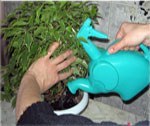 A jet of water from a watering can should not erode the soil in a pot.
A jet of water from a watering can should not erode the soil in a pot.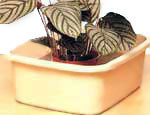 You can always keep the plant on a pallet withwater, and you can put it there only to soak the soil in water. Of course, the most common, simple and affordable method of irrigation is from a watering can. Some plants that require highly moist soil (for example, tsiperus) can instead of watering be placed in a pan with water, so that the water reaches the ground level. If the pan is wide enough, the constant evaporation of water from it will create a more humid atmosphere. If the pan is used not only for irrigation, but also for humidifying the air and the plant is standing on it constantly, you can use cat pots as a pan. They come in different colors and have a trellis on which the plant can be placed so that the roots are not in the water. If we talk about the dishes from which you water the flowers, then I would like to note that the watering can, even the smallest, is uncomfortable in some cases. For example, when you need to pour violet, which does not like water on the leaves. I am doing my "polivku" for these cases. For this, an ordinary plastic bottle of lemonade is taken, and a small hole is made in the lid of a hot nail. The empty core from the used gel pen is inserted into it. Such a bottle is especially convenient for.
You can always keep the plant on a pallet withwater, and you can put it there only to soak the soil in water. Of course, the most common, simple and affordable method of irrigation is from a watering can. Some plants that require highly moist soil (for example, tsiperus) can instead of watering be placed in a pan with water, so that the water reaches the ground level. If the pan is wide enough, the constant evaporation of water from it will create a more humid atmosphere. If the pan is used not only for irrigation, but also for humidifying the air and the plant is standing on it constantly, you can use cat pots as a pan. They come in different colors and have a trellis on which the plant can be placed so that the roots are not in the water. If we talk about the dishes from which you water the flowers, then I would like to note that the watering can, even the smallest, is uncomfortable in some cases. For example, when you need to pour violet, which does not like water on the leaves. I am doing my "polivku" for these cases. For this, an ordinary plastic bottle of lemonade is taken, and a small hole is made in the lid of a hot nail. The empty core from the used gel pen is inserted into it. Such a bottle is especially convenient for.
Special cases of watering
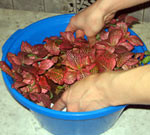
 If the soil in the pot has dried out, you need to completelyPlace the pot in warm water (25–30°C) poured into a large container, such as a basin, for a while (5–10 min). If the plant is very dry, keep the pot in the water until air bubbles stop coming out. Then take the pot out and let the water drain. There are different ways to water the crops, the main thing is to prevent the soil and seeds from being washed away in the bowl. First, you can replace watering with generous spraying of the soil. Second, cover the soil in the bowl with a cotton cloth and water through the cloth, and when the water is absorbed, remove the cloth. Third, place the bowl with the crops in a container of water and hold until the soil is moistened. Automatic watering To do this, take a narrow gauze bandage soaked in water and twist it slightly. One end of the bandage is buried in the soil of the pot to a depth of 3-5 cm, and the other is lowered into a vessel with water located below the level of the flower pot. In this case, the water level should be below the bottom of the pot.
If the soil in the pot has dried out, you need to completelyPlace the pot in warm water (25–30°C) poured into a large container, such as a basin, for a while (5–10 min). If the plant is very dry, keep the pot in the water until air bubbles stop coming out. Then take the pot out and let the water drain. There are different ways to water the crops, the main thing is to prevent the soil and seeds from being washed away in the bowl. First, you can replace watering with generous spraying of the soil. Second, cover the soil in the bowl with a cotton cloth and water through the cloth, and when the water is absorbed, remove the cloth. Third, place the bowl with the crops in a container of water and hold until the soil is moistened. Automatic watering To do this, take a narrow gauze bandage soaked in water and twist it slightly. One end of the bandage is buried in the soil of the pot to a depth of 3-5 cm, and the other is lowered into a vessel with water located below the level of the flower pot. In this case, the water level should be below the bottom of the pot.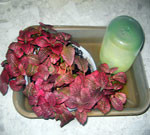 There is another method that is more commonly used.for plants that tolerate watering from a tray. The flowerpot is placed in a tray with water and a jar of water is placed there, turned upside down; the edge of the jar's neck is placed at the surface of the water. As water evaporates from the tray, it comes out of the jar.
There is another method that is more commonly used.for plants that tolerate watering from a tray. The flowerpot is placed in a tray with water and a jar of water is placed there, turned upside down; the edge of the jar's neck is placed at the surface of the water. As water evaporates from the tray, it comes out of the jar.
Important
Slow drying of the soil in the pots indicateson the diseased state or weak growth of the plant. If the plant is overwatered, it is necessary to loosen the surface of the soil or remove the top layer of soil to the roots and fill it with fresh soil. If the soil in the pot has turned sour, then you need to transplant the plant into new soil, having previously washed its roots and removed rotten parts from them. In rooms with central heating and, therefore, dry air, more frequent watering is required than in a cool room. The frequency of watering also depends on the type of pot your plant is in. In a ceramic pot, the soil dries out faster than in a plastic one. If the plant does not tolerate stagnant water in the roots or does not tolerate excess moisture in the soil, then take care of good drainage and after watering, drain the water from the tray or plate on which the pot stands.
By the way
There is such a concept as plant turgor.Turgor is the filling of plant cells with water. If the plant does not have enough water, the leaves and branches droop and become flaccid, then they say that turgor has been lost. If the plant has been dehydrated for a short time, then it is enough to thoroughly soak the soil with water so that turgor is restored. Different literature provides different methods for determining the plant's need for water. This is tapping the pot, the difference in weight, etc. I have never used these methods, since they are inconvenient and it is easy to make a mistake. First of all, you can loosen the top layer of soil; if it is not cold and crumbles into powder, then the plant needs to be watered. However, this principle is not suitable for cacti and other succulents in winter, as well as if the room is cool and the plants do not wither. In this case, it is better to wait with watering. In general, over time, at fairly constant temperatures, watering is established in a certain mode, for example, every other day in the spring, every other day in the summer, every two days in the fall, once a week in the winter. Sometimes the question arises whether it is possible to use water from a hot tap, diluting it with cold water. In fact, the chemical composition of water from a hot and cold pipe is almost the same, so if the water is soft enough, then you can use such water.









